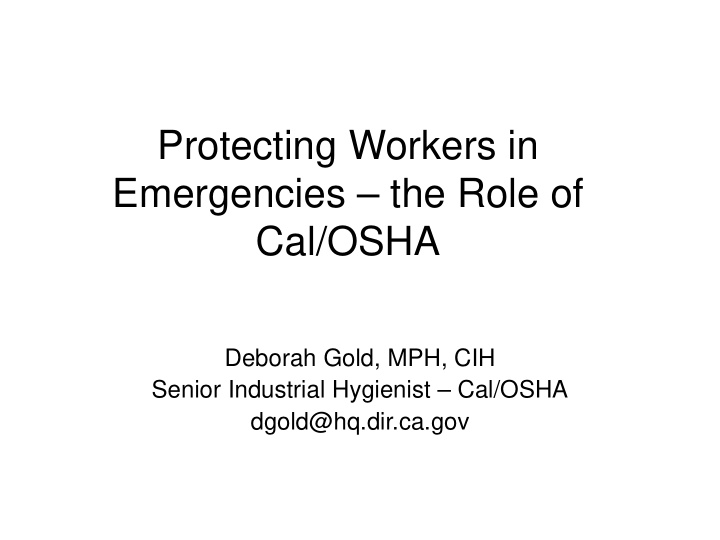



Protecting Workers in Emergencies – the Role of Cal/OSHA Deborah Gold, MPH, CIH Senior Industrial Hygienist – Cal/OSHA dgold@hq.dir.ca.gov
Incident Phases • Pre-planning, prevention, readiness • Emergency Response • Recovery • Restoration/Remediation
National Response Plan • OSHA has a role in several emergency support functions (ESFs) in the NRP including hazmat, public works and engineering, and urban search and rescue. • OSHA implements the worker safety and health support annex: – Ensures availability of safety and health resources – Provides technical advice and support – Helps develop site safety and health plan – Identifies and assesses health and safety hazards – Provides exposure monitoring, medical surveillance and monitoring (with HHS)
National Response Plan • Worker safety and health annex (cont.) – PPE program – Respirator program including fit testing – Collecting and managing injury data – Communicating with unions, contractors, and others on safety and health issues – Coordinating and providing incident-specific training – With HHS identifying appropriate immunization and prophylaxis for workers
Cal/OSHA Planning • Cal/OSHA has jurisdiction over public and private sector emergency responders • Hazwoper standard specifically addresses emergency response • Many emergency response organizations have significant problems with basic safety issues such as respiratory protection, decontamination, • Cal/OSHA participates in training exercises, workshops etc. to improve our ability to coordinate with other agencies, and to assist agencies in improving H&S components.
DURING THE EMERGENCY RESPONSE PHASE: • Provide technical safety and health assistance and advisories • Integrate into established incident commands at the field level: – Technical Specialists in Planning/Intel – Assist safety officer and help with H&S plan – May provide health and safety monitors – Advise on specific issues such as excavations, scaffolding, chemical exposures
DURING THE EMERGENCY RESPONSE PHASE (cont) • Cal/OSHA will provide representatives to local, regional and state emergency operations centers as requested. – Assist with planning. – Provide technical expertise, identification and coordination of Cal/OSHA and OSHA resources.
Cal/OSHA Resources • Cal/OSHA has about 250 health and safety experts in 22 district offices and 5 area offices throughout the state • Northern and Southern emergency response teams • Monitoring and other equipment based at the district office • Additional resources available through Federal OSHA
OSHA MISSION DURING THE RECOVERY PHASE: • WORK SITE CHARACTERISTICS: – Life-Safety Mission Completed – Clean-up or Clearance Activity – Private Contractor Oversight – Largely Public Works Operation.
Avian Flu A Different Kind of Emergency
Cal/OSHA and the Pandemic • No one knows if avian flu will become a widespread health hazard for people • A planning dilemma: – You don’t want to waste resources (that you don’t even have) – You can’t afford to be unprepared • Even if it does not become a pandemic, if highly pathogenic avian influenza comes to California, it will be an occupational risk to health care workers and people who deal with diseased birds.
Cal/OSHA Goals • Maintain our ability to protect workers in all industries by conducting on-site consultations and enforcement inspections and related activities • Ensure that workers in operations impacted by avian flu are adequately protected – Wild birds, poultry – Health care – Other high-risk environments
Pandemic phases 3, 4, 5 Adequate infection control procedures in these phases may be critical to keeping the epidemic contained • The experience of SARS shows that HCWs are at increased risk • The maintenance of a healthy, effective, health care work force, as well as emergency responders, corrections etc. is critical to our ability to get through an epidemic • We must provide adequate protection to these workers since their jobs expose them to Can we protect them so increased risk. they can do their jobs?
Eradication Workers • The last bird eradication campaign in California was for Newcastle disease. • There are few human effects of Newcastle disease. • Much more attention will need to be paid to workers who are exposed to flocks infected with avian flu. Can we protect them so they can do their jobs?
OSHA vs. Other Public Health Approaches OSHA Public Health • Mission is to protect • Mission is to protect the individual workers overall public’s health • Regulatory enforcement • Usually relies on mechanism guidelines, and enforces through licensing • Risk at work is often more concentrated than risks to • Develops risk reduction the general public measures for the general public, don’t always focus • Employees’ jobs require on specific occupational them to take risks to risks to individual workers protect others
Cal/OSHA Preplanning (Internal) • Maximize number of Cal/OSHA respirator users, and develop procedures for inspections/consultations regarding eradication, health care, etc. • Increase our ability to provide technical support in impacted operations, for example by helping with respirator training, fit-testing etc. • Cal/OSHA and DIR Continuation of Government Operations (COGO) planning
Cal/OSHA Preplanning • Input into the draft pandemic flu plan, as it applies to protecting workers, particularly in health care. • Currently meeting with DHS and CDFA , and hope to meet with other agencies, private employers, and unions on worker protection issues. • Consulting with respirator suppliers and other critical supply points. • Aerosol Transmissible Disease standard has been under development for the past two years, and should go into rulemaking later this year
Cooperation Is Key • If workers are not adequately protected, (or do not feel they are) they will have to choose between doing their jobs and their health/families. This would increase the negative impact of avian flu. • There must be a consistent, credible message coming from public agencies, employers, and unions. – All parties must be invited to the table, and be heard. – California has a lot of experience in working cooperatively to address health issues.
Find Cal/OSHA on the Web • Division of Occupational Safety and Health Home page: – http://www.dir.ca.gov/DOSH/dosh1.html • Advisory committee webpage: – http://www.dir.ca.gov/dosh/DoshReg/advisory _committee.html • Hazwoper regulation – http://www.dir.ca.gov/Title8/5192.html
Recommend
More recommend